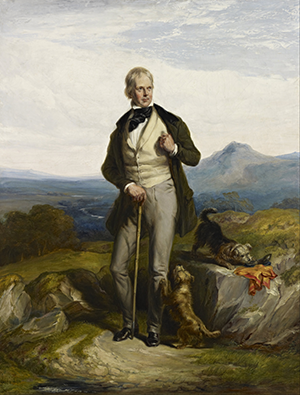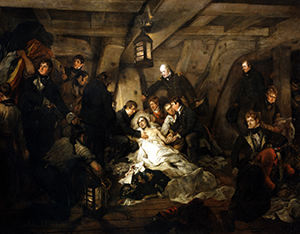ON THIS DAY
Published in Issue 5 (September/October 2017), News, Volume 25BY AODHÁN CREALEY
SEPTEMBER
21/1832

Above: Sir Walter Scott, 1771–1832. Novelist and poet, by Sir William Allan. (Scottish National Gallery)
01/1967
Siegfried Sassoon (80), novelist, biographer and one of the leading poets of the First World War, died.
06/1987
Stephen Roche, who became the first Irish rider to win the Tour de France in July that year, became the first Irish rider to win the World Professional Road Race Championship, in Villich, Austria.
12/1867
The Irish Constabulary was granted the prefix ‘Royal’—Royal Irish Constabulary (RIC)—in recognition of its role in suppressing the Fenian Rising in March of that year.
14/1967
Rupert Guinness, 2nd earl of Iveagh (93), brewer and philanthropist who presented his Dublin residence, Iveagh House (80 St Stephen’s Green, now the Department of Foreign Affairs), to the government in 1939, died.
16/1977
Maria Callas (53), internationally acclaimed Greek-American soprano, whom shipping magnate Aristotle Onassis left in favour of Jacqueline Kennedy, died of a heart attack in Paris.
18/1867
Col. Thomas J. Kelly (Head Centre of the IRB) and Capt. Timothy Deasy were rescued by Fenians from a prison van in Manchester. Police Sergeant Charles Brett was killed by the bullet that broke the lock on the door of the van.
18/1967
Sir John Cockcroft (70), British physicist who shared the Nobel Prize in Physics in 1951 for splitting the atom with Irishman Ernest Walton (1903–95), died.
19/1977
Minister for Health and Social Welfare Charles J. Haughey announced a new social welfare system, based on a simple pay-related contribution—Pay Related Social Insurance (PRSI).
23/1937
Kirkintilloch, Dunbartonshire, disaster. Ten ‘tattie-hokers’ (potato-pickers) from Achill Island, Co. Mayo, were burned to death when their bothy (farm building) caught fire as they slept.
25/1917
Thomas Ashe (32) died in Mountjoy Prison after being forcibly fed whilst on hunger strike.
27/1917
Edgar Degas (83), French painter regarded as one of the founders of Impressionism, over half of whose works depict dancers, died.
OCTOBER
21/1805

Above: The death of Admiral Horatio Nelson at the Battle of Trafalgar. Ship’s surgeon William Beatty, from Limavady, Co. Derry, couldn’t save him. (Getty Images)
04/1917
Dave Gallaher (43), Donegal-born captain of the Original All Blacks, the first New Zealand team to tour Britain and Ireland (1905–6), was killed in an attack on Gravenstafel Spur during the 3rd Battle of Ypres (Passchendaele).
04/1957
The USSR launched Sputnik 1, a 23in.-diameter metal sphere with four external radio antennas, which completed 1,440 orbits of the earth over the following three months.
05/1977
Seamus Costello (38), leader of the Irish Republican Socialist Party (IRSP), was shot dead in Dublin, the first Irish party leader to be assassinated.
08/1967
Clement Attlee (84), Labour prime minister of the United Kingdom (1945–51) and leader of the Labour Party (1935–55), the longest-ever serving leader of that party, died.
09/1967
Ernesto ‘Che’ Guevara (39), Argentine Marxist revolutionary, was captured and summarily executed by CIA-backed Bolivian forces.
10/1957
Fire broke out at the Windscale (now Sellafield) facility in Cumbria, the worst nuclear accident in British history.
14/1817
John Philpot Curran (67), lawyer and nationalist, whose daughter, Sarah, was engaged to Robert Emmet, died.
14/1917
Nathaniel Hone (86), artist, best remembered for his landscapes and seascapes, died.
15/1917
Margaretha MacLeod (41), Dutch exotic dancer and courtesan, better known by the stage name Mata Hari, was executed by firing squad in France after being convicted of spying for Germany.
20/1917
W.B. Yeats, poet and dramatist (52), married Georgie Hyde-Lees (25).
28/1868
Margaret Noble, ‘Sister Nivedita’, social worker, teacher and writer in India and advocate of Indian Home Rule, born in Dungannon, Co. Tyrone.
31/1517
Martin Luther, an Augustinian friar and university teacher, affixed 95 theses attacking various practices in the Catholic Church to the door of the main church in Wittenberg, a town between Berlin and Leipzig.
31/1867
William Parsons (67), 3rd earl of Rosse, astronomer, landlord and politician, died.
















